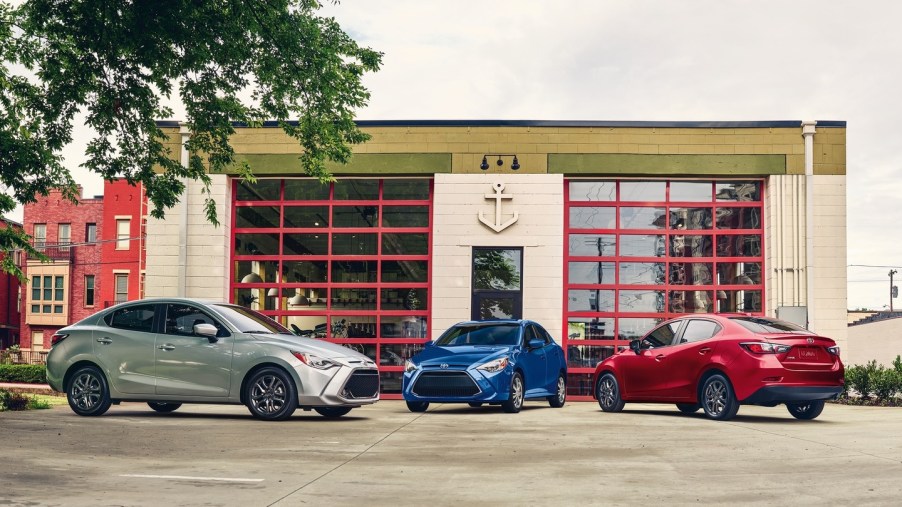
Avoid the Toyota Yaris, Get the Honda Fit Instead
Although we can’t get the Mazda2 in the US, we can get the Toyota Yaris. It’s not only one of the cheapest new cars you can buy, but it’s also fun to drive. However, we can’t get the best version, the AWD GR Yaris, and the Yaris crossover is best avoided. Also, there’s another inexpensive new car worth considering: the Honda Fit. And in many ways, especially if you need cargo space, the Fit is the better buy.
2020 Toyota Yaris specs and features

For 2020, the front-wheel-drive Toyota Yaris is available in two forms: sedan and hatchback. There are 3 sedan trim levels: $15,650 L; $16,650 LE; and $18,750 XLE. The hatchback is only available in $17,750 LE and $18,750 XLE trims.
Each Yaris comes with the same powertrain, a 1.5-liter four-cylinder making 106 hp and 103 lb-ft. A 6-speed manual is standard, though a 6-speed automatic is available. The EPA rates it at 32 mpg city/40 mpg highway with the automatic, and 30 mpg/39 mpg with the manual. However, Car and Driver only saw 33 mpg combined during its XLE sedan test.

Although the Toyota Yaris is an inexpensive subcompact, it does offer quite a few standard features. Android Auto and Apple CarPlay are standard, as is low-speed forward-collision warning, as well as keyless entry. USB ports, though, are optional extras, and the Yaris doesn’t offer additional driver-assistance features.
Car and Driver reports the base L trim should suffice for most buyers. However, if you want features like heated mirrors and push-button start, go for the LE. The XLE, meanwhile, adds a leather-trimmed multi-function wheel, LED lights, and rain-sensing wipers.
2020 Honda Fit specs and features

Although Honda has revealed a 4th-gen Fit, Car and Driver reports it may not come to the US. For now, the US only gets the 3rd-gen Honda Fit. However, the subcompact hatchback still has a lot to offer.
For 2020, the Honda Fit is available in 4 trims: $16,190 LX; $17,600 Sport; $19,060 EX; and $20,620 EX-L. All 4 come with the same 1.5-liter four-cylinder engine, though output depends on which transmission you spec. With the 6-speed manual, it develops 130 hp and 114 lb-ft. With the CVT, standard on the EX and EX-L, it makes 128 hp and 113 lb-ft instead. All CVT-equipped Honda Fits offer at least 30 mpg city/36 mpg highway. However, Car and Driver managed to get 41 mpg during its highway testing.

Although the LX is cheapest, Car and Driver recommends going for at least the Sport. This adds Android Auto, Apple CarPlay, as well as a 7” touchscreen. If you go for the CVT, you can also add Honda’s ADAS suite, which includes lane-keeping assist, adaptive cruise control, and automatic emergency braking. This suite is standard on the EX and above.
Fit vs. Yaris
Although the Toyota Yaris may be the better-handling subcompact, in terms of daily usability, the Honda Fit is the better buy.
Although it’s the same size as the Yaris, Car and Driver reports the Fit has noticeably more interior space. And yet, it can still hold just as much cargo. Autotrader reports that the Honda hatchback could even make a decent family car. It helps that, although it is more expensive, the Honda Fit can be equipped with more safety features. Admittedly, both cars received 5 stars from the NHTSA.
The Honda Fit is also faster to 60 than the Toyota Yaris. That may not seem like it matters, but it does mean highway passes are easier in the Honda than the Toyota. And, because the Fit’s engine doesn’t have to work as hard to accelerate, it won’t burn as much fuel. Although Car and Driver recorded 33 mpg in its Yaris XLE sedan test, a separate test with more elevation changes saw the hatchback drop to 26 mpg.
Dynamically, the Toyota Yaris has the edge over the Honda Fit. But for practicality, the Honda is the one to get.
Follow more updates from MotorBiscuit on our Facebook page.


